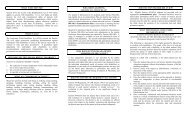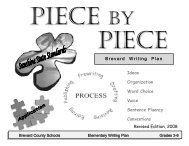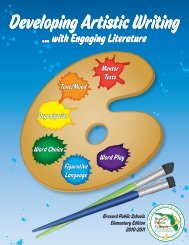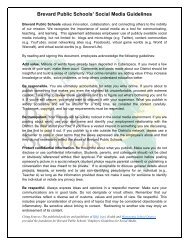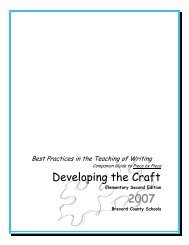2007-08 K-12 Comprehensive Research-Based Reading Plan
2007-08 K-12 Comprehensive Research-Based Reading Plan
2007-08 K-12 Comprehensive Research-Based Reading Plan
You also want an ePaper? Increase the reach of your titles
YUMPU automatically turns print PDFs into web optimized ePapers that Google loves.
in middle grades and high school. Therefore, caution is suggested in using fluency datafor placement in reading intervention in the upper grades.Schools must diagnose specific reading deficiencies of students scoring at Level 1 andLevel 2 on FCAT <strong>Reading</strong>. Although formal diagnostic assessments provide specificinformation about a student’s reading deficiencies, many progress monitoring tools andinformal teacher assessments can provide very similar information in a more efficientmanner. The only reason to administer a formal diagnostic assessment to any student isto determine the specific deficit at hand so teachers can better inform instruction tomeet student needs. The decision to deliver a formal diagnostic assessment should bethe result of an in-depth conversation about student instructional and assessment needsby the teacher, reading coach, and reading specialist.Assessment/Curriculum Decision Tree (Chart G) demonstrates how assessment datafrom progress monitoring and other forms of assessment will be used to determinespecific interventions for students at each grade level.4. How will the district ensure extended intervention time is provided for students in needof decoding and text reading efficiency at the middle school level?All secondary schools are required to provide Intensive <strong>Reading</strong> classes for allstudents who scored Level 1 or 2 on the previous year’s FCAT. If a student isdetermined to need additional support in the areas of decoding and text readingefficiency, based on Brevard’s Assessment Decision Tree, he/she will be placed in anadditional reading class to provide extended time for intensive intervention. Thisstudent will receive two periods of reading (back to back) in addition to the regularLanguage Arts class. Student Information System reports will be reviewed during FTEsurvey periods to ensure all schools, including charter schools, are adhering to therequirement of extended intervention time for these students.5. How will students be provided with access to authentic fiction and non-fiction textsrepresenting a range of levels, interests, genres, and cultures within the readingprogram? Include the following: a) how daily independent reading, monitored by theteacher, will be incorporated into all reading classrooms; b) how classroom librarieswill be utilized; c) the process for leveling books; and d) the process for matchingstudents with the appropriate level of text.Involvement of classroom teachers, media specialists and parents help to guide ourstudents to appropriate reading selections. Common Core Text Exemplars provide asample of appropriate grade level text with complex language, structure and content.Teachers and media specialists will refer to the Common Core Text Exemplars as theytransition from solely matching students to text to selecting text for their instructionalpurpose. A district priority for the upcoming reading adoption is to select a programthat provides a wide range and quality of complex text. As we move forward withCommon Core State Standards implementation, teachers will be provided training onhow to use complex text for close reading purposes as well as enriching Read Aloudsand small group instructional time through utilizing complex text.27 | P a g e








